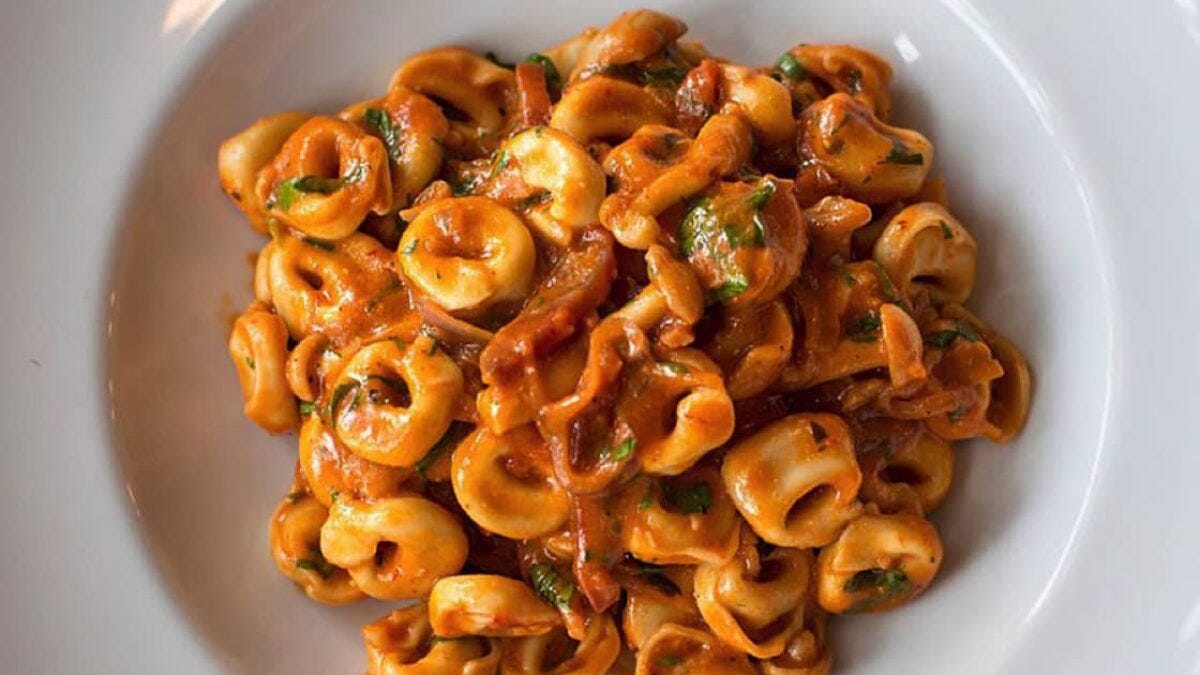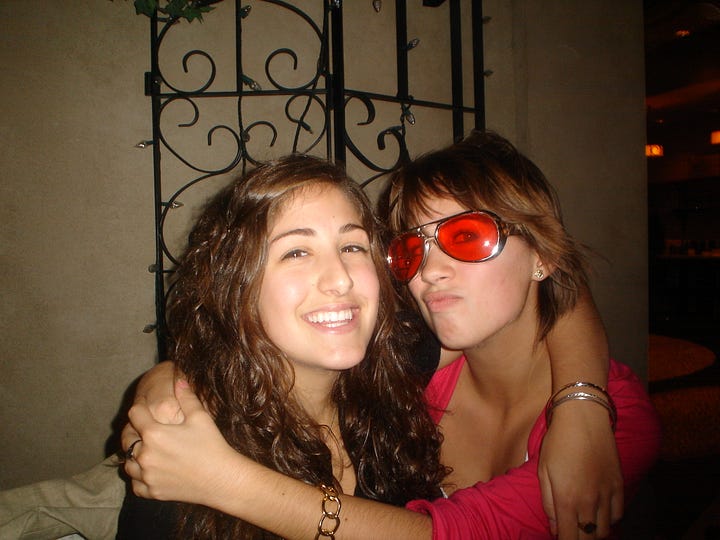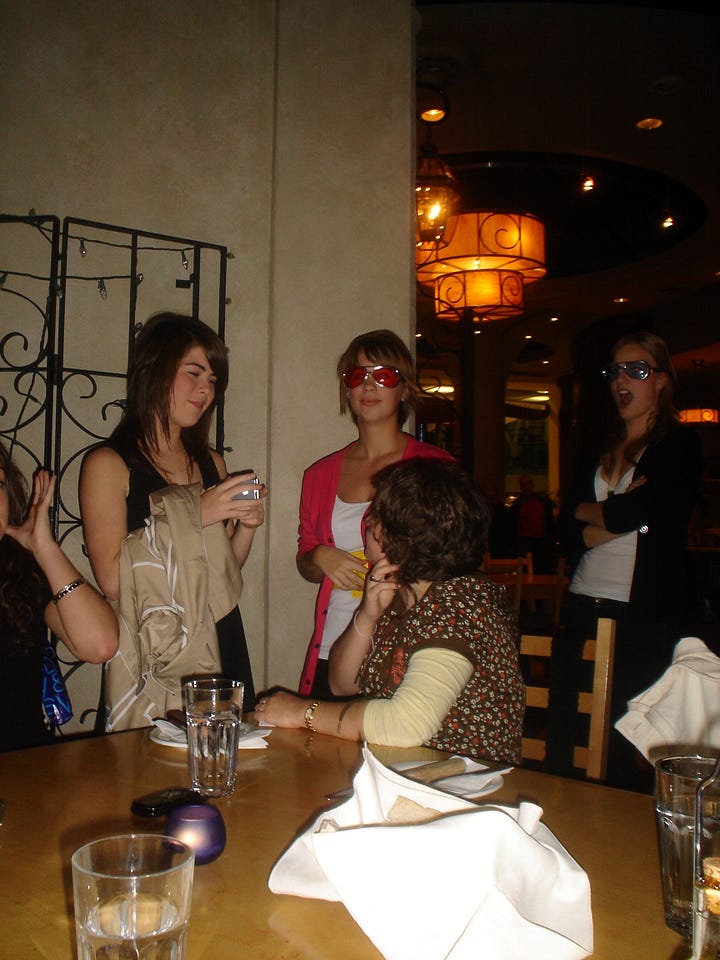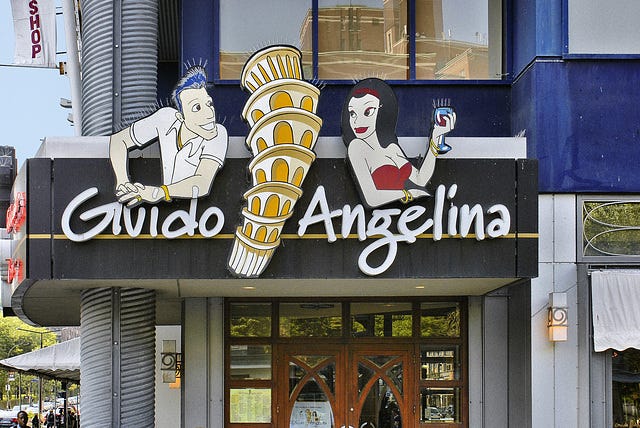Let me start this off by saying that my Italian boyfriend told me not to write this post. “It’s risky,” he warned, “you can lose all your credibility.” But something I’ve been very interested in lately is the intersection between “good” and “bad” food, and “authentic” versus “Americanized” Italian food, in particular. You can see this in my April newsletter - “Con uovo” - where I wrote about the history and significance of egg drop soups, including the Lipton adaptation used by many Italian-Canadian families in a pinch. You’ll also be able to read my reflections on this in the upcoming issue of kitchen work, where I write about growing up and eating in Saint-Leonard, a historically Italian area in Montreal’s east end. Though I was raised “very Italian,” which came with a profound appreciation for homemade and home grown meals, Harvey’s, a Canadian burger chain, holds a special place in our family story.
So today, I want to expose myself and my, some might say, extremely questionable childhood and tweenagehood taste in order to encourage you to think more deeply about what it means to be “authentic” and “good.” And maybe to get vulnerable enough to share your own problematic faves.
Questionable dish #1: Tortellini alla Gigi

Look, I’ll still stand by this dish today. Honestly, I have been a rosée sauce fiend since I discovered it at Guido & Angelina, in the form of penne alla romanoff (or alla vodka). Guido & Angelina is a now closed-down restaurant chain that served up the best of the best Americanized Italian food. As I started to venture downtown with my friends in high school, this became one of our regular haunts. I can’t tell you the amount of birthday parties celebrated in that dining room. I always got the penne alla romanoff.




As for my first introduction to tortellini alla Gigi - a rosée-based dish that also includes small slices of pancetta and mushrooms - that came later, at a restaurant in Little Italy. I’m pretty sure it was the one mentioned in Stefano Faita’s recipe, Casa Cacciatore (which is now also closed), though I’m not completely sure. An abominable mix of so many delicious things, I adored it.
I have searched for the history of this dish, but can’t seem to find anything at all. Was it invented here, in Canada? In the States? Is it “actually” Italian? I have no clue and it seems like no one else does either. There’s a bit more clarity surrounding the origins of rosée sauce (aka salsa aurora, made by mixing flour, butter, milk, and salt with tomato sauce) and penne alla vodka, which seems to have been popularized in Italy and/or the States in the 1980s. Apparently New York City, Bologna, and Rome all lay claim to its invention: food historians and urban legends have credited this dish to Chef Luigi Franzese of New York’s Orsini restaurant; James Doty, a Columbia student; Bologna’s Dante restaurant; or a Roman chef who worked for a vodka company.1 Recently, it’s become known as “Gigi Hadid Pasta” (not to be confused with Gigi of the tortellini, who is still a mystery), as her recipe for the dish went viral in a 2020 Instagram story.
If you know more about the story of tortellini alla Gigi - maybe you know Gigi?! - please share.
Questionable dish #2: Hawaiian pizza
Don’t you dare say a word (and also please note that comments are not open for debate on whether pineapple belongs on pizza; let people live and order something else if you don’t like it). Though I have grown out of this particular flavour combination, as I kid, I loved the sweet and saltiness and absolute chaos of this pizza.
To my dad’s chagrin (as he actually makes a really delicious pizza, inherited from his late uncle, thanks to working alongside him in his restaurant), my sister and I were obsessed with Pizza Hut as kids. I really think they reeled us in with the sundae machine, more than anything else. Nevertheless, it was a popular take-out option in our household. To his even deeper chagrin, they would have to order half a Hawaiian pizza for me.
The history of the controversial Hawaiian pizza is well-known, and comes out of the 1960s “tiki trend”:
“Sam Panopoulos, who was born in Greece and moved to Canada when he was 20, decided to try out pineapple on pizza in 1962 to attract customers to one of his Ontario-based restaurants. Panopoulos said he and his brothers enjoyed the contrast between the pineapple’s sweetness and the savoury flavor of the ham also added to the pizza. They named it Hawaiian pizza after the brand of canned pineapple used on the pie.”2
Italians are often scared, disgusted, and angered by North American creations or “corruptions” of their food. Alongside chicken alfredo pasta (we’ll get to alfredo in a second…) and carbonara with cream, I would say that the pineapple pizza is up there as one of the most offensive concoctions. However, even Vincenzo Prosperi, of the YouTube channel Vincenzo’s Plate, came up with an “Italian approved” version of the dish, without tomato sauce (this seems to be the biggest turn off: the combo of the sauce with pineapple).
It was a phase. It happens. I would try Vincenzo’s version, though.
Questionable dish #3: Michelina’s lasagna alfredo
This one is by far the worst and most embarrassing of all. I don’t know what they put in these, but I truly was hooked on the Michelina’s lasagna alfredo with broccoli and mozzarella. I didn’t care for the others at all, but this microwavable monstrosity, I could have eaten it for lunch every day. Look, I can’t defend this one. There isn’t much to say.
Michelina’s is named after the founder’s mother, who they describe as an incredible cook. I don’t doubt that. But uh… I don’t think these are her original recipes. It’s probably not the worst of the ready-made “Italian food” out there (Chef Boyardee is still lurking in a canned goods aisle at a grocery store near you), but you can make a better and cheaper version of this at home.
Digging Deeper
Now that I’ve put myself on the line, we can get to the bigger picture: authenticity and how it is used to moralize food as “good” or “bad.” Let me start off by saying that I will laugh at an Italians Mad at Food post as much as the next person. I love watching people get passionate about food and show their own traditions behind dishes that may have been changed through migration and generations in diaspora.
I’m also very interested in the discourse challenging the myths of Italian food traditions, led by scholars like Massimo Montanari. Recently, academic Alberto Grandi made headlines for basically stating that “Italian food doesn’t exist:”
“Grandi’s speciality is making bold claims about national staples: that most Italians hadn’t heard of pizza until the 1950s, for example, or that carbonara is an American recipe. Many Italian ‘classics’, from panettone to tiramisù, are relatively recent inventions, he argues.”3
The argument at the heart of their work being that the titans of culinary industry and culture in Italy worked towards cementing a marketable identity, which would be accessible enough to encourage tourism but rigid enough to discourage the idea that you could find anything comparable anywhere else. Of course, this is not meant to knock the quality of the product, as many Italian businesses and organizations work extremely hard to produce exceptional goods. I mean, Michelina’s is really not comparable to even the worst meal I’ve had in Italy. The issue is the creation of authenticity; of saying there is only one correct way to do it, and nothing else is valid. Regions, cities, and villages can have their specialties. But, historically, those specialties have probably varied more than we have come to imagine.
And honestly… Panopoulos never claimed any kind of authenticity with his pineapple pizza. So let’s cool it. Michelina’s does use “authentic” on their packaging as a marketing tactic, though I don’t know who they think they’re fooling.

The way “authenticity” is thrown around has always interested me. Especially, the way we look for it, yearn for it. Why is “authenticity” so marketable, so financially viable?
What does it mean to be authentically Italian, in the context of immigration? Teasing out that answer is extremely complicated and, sometimes, problematic: do we put boundaries on people’s italianità if, for example, they weren’t given the opportunity to learn the language, or have lost much of it in adulthood? Are we allowed to have our own version of authentic “Italianess,” rooted in our particular histories and contexts? Can we eat spaghetti and meatballs in peace?
What are your “problematic faves” in diaspora cuisine? Share some memories around these dishes.
How do you connect with your italianità? Do you feel the weight of “authenticity” on your shoulders?
Are there limits to adaptation of recipes? Why or why not?
Cass
I found these explanations in a few places: https://www.paesana.com/blog/the-story-behind-the-sauce-vodka; https://www.cook-italian.com/weblog/2009/09/penne-ala-vodka-recipe.html; https://www.mashed.com/429529/the-mysterious-origins-of-penne-alla-vodka/.
Source: https://time.com/4814056/hawaiian-pizza-pineapple-sam-panopoulos-death/.
Source: https://www.ft.com/content/6ac009d5-dbfd-4a86-839e-28bb44b2b64c.









ahh this has me thinking so many thoughts about chinese food authenticity in my family… like food traditions asian american/canadian pop culture tells me are supposed to be passed down such as making homemade dumplings (which my family doesn’t do) or how in reality many chinese diasporas exist each with our own food traditions. Thank you for sharing your own!
(and as for americanized foods…personally, I still love to order Orange Chicken from time to time 😅)
Loved this! I grew up in a middle class WASP-y home in Newfoundland, so the processed foods like Michelina's bring me back to my childhood – although without the complexities of an Italian heritage. Also, pineapple pizza ... love it. 😊